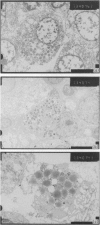Abstract
The development of FcR epsilon-bearing histamine-containing basophilic cells was studied in cultures of peripheral blood leucocytes and bone marrow leucocytes from normal individuals. The determination of basophilic cells was performed blindly. Before cultivation there were fairly similar numbers of basophilic cells in the samples from the three different sources (1.6 +/- 1.6 n = 13; 1.4 +/- 2.0 n = 21; 4.3 +/- 4.7 n = 8, respectively). During cultivation spontaneously appearing large blast-like basophilic cells were seen in good correspondence with a formation of histamine in the cultures (Spearman rank correlation coefficient = 0.9135, n = 13, P less than 0.001). This was more accentuated with bone marrow cells than with peripheral blood and cord blood cells. Conditioned medium (CM) was prepared from cells isolated from various tissues and stimulated by different means, e.g. peripheral blood from atopic individuals stimulated with allergen and unstimulated tonsil cells. Addition of the CM resulted in increased development of histamine-containing basophilic cells. Optimum stimulation was achieved with 10% CM. The basophilic stimulation by CM, as assessed as indices vs. unstimulated cultures, was more accentuated in cultures of peripheral blood cells than of bone marrow and cord blood cells (2.8 +/- 1.2; 1.8 +/- 0.5; 2.0 +/- 0.4, respectively). In contrast, the histamine formation was particularly evident in stimulated cultures of bone marrow cells, where more than four-fold increases of histamine were found. In bone marrow cells the histamine levels per basophilic cell also increased, whereas this was not the case in cord blood cells. A pronounced development of basophilic cells was achieved when using leukoagglutinin, provided the mitogen in the CM was eliminated. The formation of basophilic cells was prevented with mitomycin c and cycloheximide. In conclusion, the system described may provide important information on the development of histamine-containing basophilic cells at various maturation stages from different compartments, and mechanisms in a developing atopic disease.
Full text
PDF






Images in this article
Selected References
These references are in PubMed. This may not be the complete list of references from this article.
- Ahlstedt S., Olaisson E., Thellin J., Björkstén B. Appearance of mast cells in bone marrow, peripheral blood and spleen of immunized rats. Int Arch Allergy Appl Immunol. 1986;80(2):122–126. doi: 10.1159/000234038. [DOI] [PubMed] [Google Scholar]
- Ceska M., Lundkvist U. A new and simple radioimmunoassay method for the determination of IgE. Immunochemistry. 1972 Oct;9(10):1021–1030. doi: 10.1016/0019-2791(72)90112-7. [DOI] [PubMed] [Google Scholar]
- Denburg J. A., Richardson M., Telizyn S., Bienenstock J. Basophil/mast cell precursors in human peripheral blood. Blood. 1983 Apr;61(4):775–780. [PubMed] [Google Scholar]
- Denburg J. A., Telizyn S., Ahlstedt S., Olafsson J. H., Roupe G., Bienenstock J. Basophil/mast cell precursors in mast cell proliferative disorders. Clin Invest Med. 1986;9(1):21–25. [PubMed] [Google Scholar]
- Denburg J. A., Telizyn S., Belda A., Dolovich J., Bienenstock J. Increased numbers of circulating basophil progenitors in atopic patients. J Allergy Clin Immunol. 1985 Sep;76(3):466–472. doi: 10.1016/0091-6749(85)90728-6. [DOI] [PubMed] [Google Scholar]
- Denburg J. A., Wilson W. E., Goodacre R., Bienenstock J. Chronic myeloid leukaemia: evidence for basophil differentiation and histamine synthesis from cultured peripheral blood cells. Br J Haematol. 1980 May;45(1):13–21. doi: 10.1111/j.1365-2141.1980.tb03806.x. [DOI] [PubMed] [Google Scholar]
- Dvorak A. M., Ishizaka T., Galli S. J. Ultrastructure of human basophils developing in vitro. Evidence for the acquisition of peroxidase by basophils and for different effects of human and murine growth factors on human basophil and eosinophil maturation. Lab Invest. 1985 Jul;53(1):57–71. [PubMed] [Google Scholar]
- Dvorak H. F., Mihm M. C., Jr Basophilic leukocytes in allergic contact dermatitis. J Exp Med. 1972 Feb 1;135(2):235–254. doi: 10.1084/jem.135.2.235. [DOI] [PMC free article] [PubMed] [Google Scholar]
- Fishman P., Djaldetti M., Hart J., Sredni B. Growth of human basophil lines derived from chronic myelocytic leukaemia cells in vitro: ultrastructure and X-ray microanalysis studies. Immunology. 1985 May;55(1):105–113. [PMC free article] [PubMed] [Google Scholar]
- Gilbert H. S., Ornstein L. Basophil counting with a new staining method using alcian blue. Blood. 1975 Aug;46(2):279–286. [PubMed] [Google Scholar]
- Golde D. W., Quan S. G., Cline M. J. Human T lymphocyte cell line producing colony-stimulating activity. Blood. 1978 Nov;52(5):1068–1072. [PubMed] [Google Scholar]
- Ishizaka T., Dvorak A. M., Conrad D. H., Niebyl J. R., Marquette J. P., Ishizaka K. Morphologic and immunologic characterization of human basophils developed in cultures of cord blood mononuclear cells. J Immunol. 1985 Jan;134(1):532–540. [PubMed] [Google Scholar]
- Ogawa M., Nakahata T., Leary A. G., Sterk A. R., Ishizaka K., Ishizaka T. Suspension culture of human mast cells/basophils from umbilical cord blood mononuclear cells. Proc Natl Acad Sci U S A. 1983 Jul;80(14):4494–4498. doi: 10.1073/pnas.80.14.4494. [DOI] [PMC free article] [PubMed] [Google Scholar]
- Soler J., O'Brien M., de Castro J. T., Miguel J. F., Kearney L., Goldman J. M., Catovsky D. Blast crisis of chronic granulocytic leukemia with mast cell and basophilic precursors. Am J Clin Pathol. 1985 Feb;83(2):254–259. doi: 10.1093/ajcp/83.2.254. [DOI] [PubMed] [Google Scholar]
- Tadokoro K., Stadler B. M., De Weck A. L. Factor-dependent in vitro growth of human normal bone marrow-derived basophil-like cells. J Exp Med. 1983 Sep 1;158(3):857–871. doi: 10.1084/jem.158.3.857. [DOI] [PMC free article] [PubMed] [Google Scholar]




